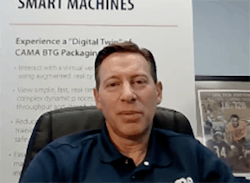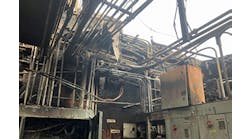“Because people can’t get to a factory to troubleshoot or train, there’s also the cost of time and travel. The initial barriers are starting to be perceived as gone, and now we can start moving forward full force.” Cama North America’s Billy Goodman explains how technology has kept plants operational during the global pandemic during the OEM Industry Forum at this week’s Automation Fair at Home, presented by Rockwell Automation.
Manufacturers have been inching their way along an inevitable path toward digital transformation. Two steps forward and one step back seemed to be the norm when it came to adopting new technologies and assuming the undetermined risks that accompanied them. Still, they persevered, and factories moved toward automated 24/7 operations, slowly implementing one new technology after another, assessing costs and mitigating risks. It’s been a slow evolution.
But the COVID-19 pandemic changed all of that in a hurry. Suddenly, plants needed to remain operational, but without putting humans in direct contact with one another. And organizations quickly discovered that the solution had been right under their noses the whole time.
“I’m constantly amazed by the advancement in technology,” said Billy Goodman, managing director, Cama North America. “We are focused on automating our customers’ facilities with technologies like online support and the digital twin.”
Goodman was one of the panelists who spoke at today’s OEM Industry Forum during Automation Fair at Home, presented by Rockwell Automation.
Another company represented in the forum panel, Sani-Matic, has been an OEM brand for more than 75 years. “We’ve become adept at adaptation,” said Bryan Downer, VP of sales and marketing, Sani-Matic. “Like everyone else, we’ve had to adapt in this ever-changing year. Our cloud-based data monitoring software allows our customers to monitor their equipment from any interactive device.”
Customer needs are the same today as they were prior, explained Goodman, but the elephant in the room—maintaining operations during a pandemic—has been a catalyst for transformation. “Our customers need to be running 24 hours a day, 7 days a week,” he said. “The pandemic has pushed us forward.”
How can automation solve problem? “We need to solve them now, but how do we maintain it?” asked Downer. “Should there be virtual access? A lot of people are scratching their heads trying to figure out how to do it.”
Prior to the pandemic, Cama North America was using the Nike slogan: “Just do it,” said Goodman. “We’ve found that, to date, there have been no issues with cybersecurity,” Goodman added. “There was a cost element to it, but, because people can’t get to a factory to troubleshoot or train, there’s also the cost of time and travel. The initial barriers are starting to be perceived as gone, and now we can start moving forward full force.”
Cybersecurity had been an issue, but that’s changed a bit, said Downer. “We see it starting to diminish,” he explained. “One barrier now is the reluctance to embrace change. Often, people are trying to do what they need to for the immediate future without developing a long-term plan.”
Another major hurdle is how to convince customers and make them understand the benefits of using the technology, said Mika Ide, chief of sales engineering, Hirata. “It is difficult to draw a clear line of what costs will be incurred. We need to make a quick decision. As a system integrator, we are focused on the use of 3D models by sales and maintenance engineers,” she explained.
“For a lot of OEMs, we’ve had to educate the customer,” added Downer. “We’re not experts on everything either. We rely on partners like Rockwell Automation. Education is a big piece of this.”
That education used to be explaining what the equipment is and how it works on the line, explained Goodman. “Now it’s how to maintain the equipment. That follow-up in training and reducing the skill gap on implementation is huge.”
Downer agreed on the importance of training for the future. “Several months ago, we took our entire customer journey map and looked at the touch points, from engaging them all the way through the lifecycle,” explained Downer. “There’s more we can do now, as we have connectivity to the system. We can provide them with on-demand training and virtual technical support.”
Cama North America is using the digital twin to show how a machine will function. “We’re also finding that there’s an alleviation of risk because we can test speeds and cycles through the digital twin,” he explained.
Cloud data is another helpful piece of technology. “It allows our customers to audit cleaning cycles, look at history and meet requirements of the federal government across multiple plants,” explained Downer.
Cama North America can now do a trend analysis for moving parts. “Before this, you’d look for metal shavings or touch for heat,” explained Goodman. “Now, you can look at the history, and that can allow you to avoid an e-stop. And you don’t have to send a person there—you can see it remotely.”
The COVID-19 pandemic has caused many surprises. “The biggest surprise is how quickly our customers have found ways to maintain adequate security to allow connectivity,” said Downer. “A year ago, it would have been impossible to find a quick implementation of remote connectivity. When you couldn’t get people in the plant, they had to find out ways to make it work.”
The editors of Control, Control Design and Smart Industry are providing coverage of Automation Fair At Home, bringing you breaking news, innovations and insights from the virtual event. Once Automation Fair At Home is over, the editors will put together an event report featuring the top news. Pre-order your copy today.






